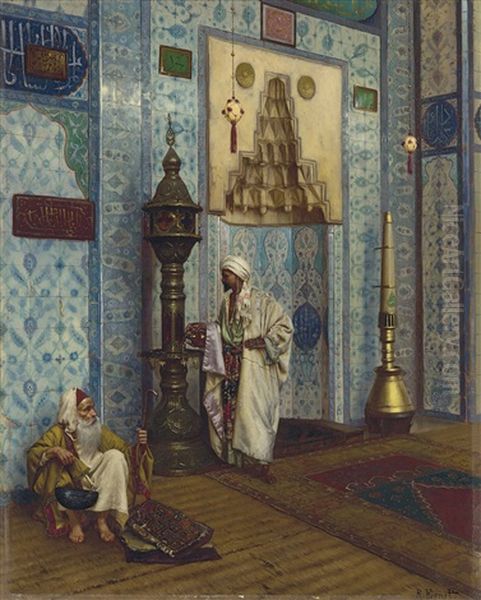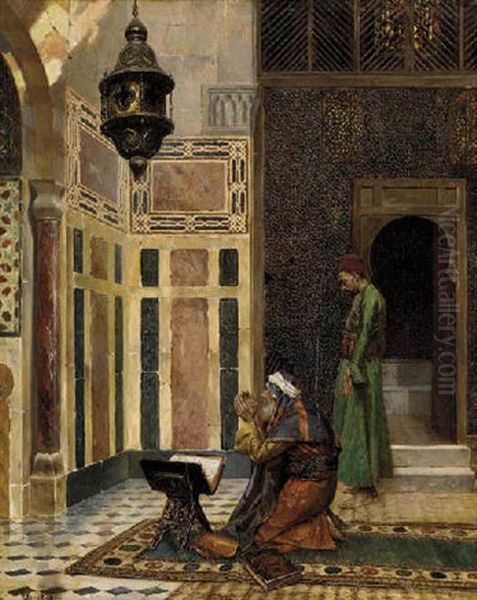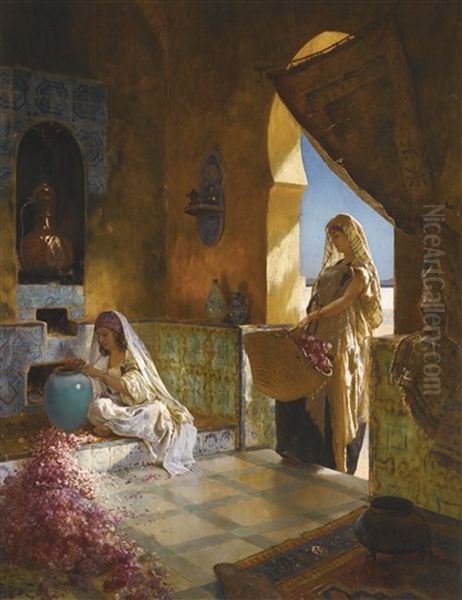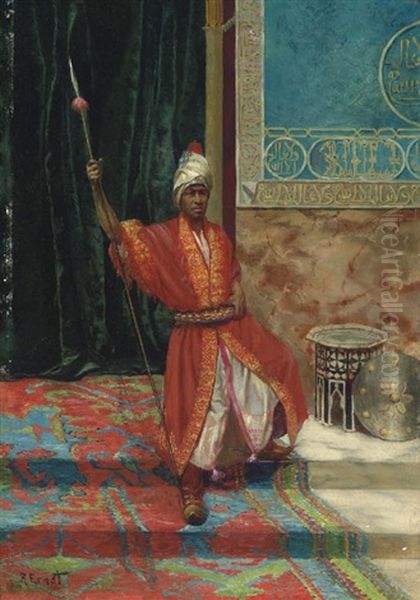Rudolf Ernst stands as a significant figure in the Orientalist movement of the late nineteenth and early twentieth centuries. An artist of Austrian origin who found his greatest success in France, Ernst dedicated his career to capturing the essence of the Near East and North Africa through meticulously detailed and atmospherically rich paintings. His work, celebrated for its technical brilliance and evocative power, offers a fascinating window into the European perception of the 'Orient' during his time.
Early Life and Academic Foundations in Vienna
Born in Vienna in 1854, Rudolf Ernst was immersed in an artistic environment from a young age, as his father was a painter for the Imperial Academy. This familial connection likely fostered his early interest in the arts. He formally began his artistic training at the prestigious Vienna Academy of Fine Arts (Akademie der bildenden Künste Wien).
During his time at the Academy, Ernst studied under influential figures of the Austrian art scene. One of his primary mentors was Anselm Feuerbach, a leading proponent of Neoclassicism in Germany and Austria. Under Feuerbach, Ernst would have honed his skills in drawing, composition, and the depiction of historical and mythological subjects, likely focusing initially on portraiture and landscape painting as mentioned in his early training records.
Ernst also studied with August Eisenmenger, another respected professor at the Vienna Academy known for his historical paintings and decorative works, including frescoes for prominent Viennese buildings. Eisenmenger's guidance would have further solidified Ernst's technical proficiency and understanding of academic painting traditions. This rigorous training provided him with the foundational skills in draughtsmanship and oil painting technique that would later underpin his detailed Orientalist works.
The Journey to Rome and the Allure of the Past
Following his studies in Vienna, Ernst, like many aspiring artists of his generation, traveled to Italy. He spent time in Rome, immersing himself in the study of Classical antiquity and the masterpieces of the Italian Renaissance and Baroque periods. This journey was a traditional step for academically trained artists, meant to deepen their understanding of Western art history and refine their technique by copying the masters.

His time in Rome allowed him to study the works of artists admired by his teacher Feuerbach and others in the Neoclassical tradition. This experience likely reinforced his appreciation for clarity of form, balanced composition, and the idealized representation of the human figure, elements that, while adapted, subtly inform the structure and rendering within his later Orientalist paintings. The rich colours and dramatic lighting of Baroque masters may also have left an impression.
The Pivotal Shift: Embracing Orientalism
A significant turning point in Ernst's career occurred around 1884-1885. He began to move away from the historical and genre subjects typical of his academic training and embraced Orientalism, a theme that would dominate his artistic output for the rest of his life. This shift was profoundly influenced by his travels outside of Europe.
Ernst journeyed extensively through regions that captivated the European imagination: Morocco, Spain (particularly Andalusia with its Moorish heritage), Egypt, Tunisia, and importantly, Constantinople (modern-day Istanbul), the heart of the Ottoman Empire. These travels were not mere sightseeing tours; they were expeditions for artistic inspiration and source material. He gathered sketches, took photographs, and likely collected artifacts like textiles, ceramics, and metalwork.
This direct exposure to the cultures, architecture, light, and daily life of these regions provided him with a wealth of authentic detail that he would later incorporate into his paintings. The vibrant colours, intricate patterns, exotic costumes, and architectural splendors he witnessed firsthand became the building blocks of his artistic vision. His 1885 trip to the Middle East is often cited as particularly crucial in cementing his dedication to Orientalist subjects.
The Signature Style: Detail, Atmosphere, and Colour
Rudolf Ernst developed a highly distinctive artistic style characterized by an extraordinary attention to detail, a palpable sense of atmosphere, and a rich, often jewel-like colour palette. His works are frequently described as having a photographic realism, yet they are carefully constructed compositions designed to transport the viewer.
His meticulousness is evident in the rendering of surfaces: the intricate geometric patterns of Islamic tiles (zellij), the complex inlays of mother-of-pearl on furniture, the rich textures of silk and velvet garments, the gleam of polished brass and copper vessels, and the elaborate carvings of wooden screens (mashrabiya). He painstakingly recreated these elements, often relying on the sketches, photographs, and objects he had collected during his travels or acquired later.

Beyond mere accuracy, Ernst masterfully manipulated light and shadow to create a specific mood, often one of quiet contemplation, scholarly focus, or opulent serenity. Sunlight might filter through a latticed window, illuminate intricate details, or cast deep shadows, enhancing the three-dimensionality and atmosphere of the scene. His use of colour was equally deliberate, employing deep reds, blues, greens, and golds to convey the richness and vibrancy he associated with the East.
Common Themes and Representative Works
Ernst's oeuvre primarily focuses on scenes of daily life, religious practice, and leisure within Islamic cultures, particularly those of North Africa and the Ottoman Empire. He rarely depicted dramatic historical events or overt political commentary, preferring instead more intimate or archetypal scenes.
Common subjects include scholars reading or writing in opulent interiors, guards standing sentinel in elaborate doorways, men playing chess, individuals engaged in prayer within mosques, scenes within harems (often idealized and emphasizing luxury rather than sensuality), and artisans at work. Mosque interiors were a recurring theme, allowing him to showcase his skill in depicting complex architectural spaces adorned with tiles and carpets, often suffused with a reverent light.
Several works stand out as representative of his style and themes:
The Letter (La lettre): This painting, housed in the Dahesh Museum of Art, exemplifies his detailed interior scenes, showcasing rich textiles, intricate tilework, and a contemplative figure, likely within a harem setting. The work sold for $23,000 back in 1995, indicating early collector interest.
Leaving the Mosque (La Sortie de la Mosquée): Depicting figures emerging from a mosque, this subject allowed Ernst to combine architectural detail with studies of figures in traditional attire, capturing a moment of public religious life.
In the Harem Drinking Tea: Such scenes focused on moments of leisure and luxury, featuring finely dressed figures, elaborate furnishings, and the ritual of tea service, playing into European fantasies of harem life.
The Escort: Noted for its photographic precision and vivid colour combinations, this work likely depicts guards or attendants, showcasing Ernst's skill in rendering figures and costumes with striking realism.
The Chess Game (La partie d'échecs): Held by the Musée des Beaux-Arts in Nantes, this painting portrays a common pastime, allowing for detailed depiction of figures, setting, and the focused intensity of the players.
In the Mosque: A theme revisited often, these works highlight Ernst's fascination with Islamic religious architecture and the atmosphere of devotion, often focusing on the play of light on intricate surfaces.
These works consistently demonstrate his commitment to detailed rendering, atmospheric lighting, and the evocation of an exotic, carefully constructed world.
Flourishing in Paris: Salons and Recognition

Sometime after his initial travels, likely in the mid-1880s, Rudolf Ernst moved to Paris, the undisputed centre of the art world at the time. This move proved highly beneficial for his career. He became a French citizen and adopted the French version of his name, "Rodolphe Ernst," for signing his works and participating in the Parisian art scene.
He became a regular exhibitor at the prestigious Paris Salon, the official art exhibition of the Académie des Beaux-Arts, showcasing his Orientalist paintings for roughly three decades. Consistent participation in the Salon was crucial for an artist's reputation and commercial success during this period. His meticulously crafted and visually appealing works found favour with critics and collectors alike.
His growing reputation was solidified when he was awarded a bronze medal at the Exposition Universelle (World's Fair) held in Paris in 1889, the same exposition for which the Eiffel Tower was built. This international recognition further boosted his standing. He established friendships within the Parisian art community, connecting with fellow artists like the Austrian painter Franz Simm and potentially Charles Willard, relationships that helped solidify his position.
Ernst also took on students, passing on his knowledge and techniques. Among those recorded as having studied with him are Frédéric Steinmann and Mademoiselle Eléonore Hilda, who themselves went on to become artists. His studio in Paris likely became a repository for the various props – textiles, ceramics, furniture, hookahs – that appear repeatedly in his paintings, allowing him to compose his scenes with a high degree of control.
Ernst in the Context of Orientalism and Contemporaries
Rudolf Ernst operated within the broader European artistic and cultural phenomenon of Orientalism. This movement, fueled by colonialism, trade, travel, and a romantic fascination with cultures perceived as exotic and different, saw numerous Western artists turn their attention to the Middle East, North Africa, and Asia. Ernst became one of the leading figures of the later phase of Orientalism, particularly known for his polished, highly detailed style.
He was, of course, not alone in this field. He followed in the footsteps of earlier pioneers like Eugène Delacroix, whose Romantic and dramatic depictions of North Africa in the 1830s had ignited French interest. Ernst's work, however, generally lacked the overt drama and painterly looseness of Delacroix, aligning more closely with the academic precision popular later in the century.

His most direct contemporaries and competitors included artists like Jean-Léon Gérôme, perhaps the most famous academic Orientalist painter in France. Gérôme shared Ernst's penchant for meticulous detail and ethnographic accuracy (or perceived accuracy), though Gérôme often tackled historical scenes or subjects with a stronger narrative element. Both artists utilized photography as a tool.
Another key figure was Ludwig Deutsch, also an Austrian painter who settled in Paris and specialized in highly detailed Orientalist scenes very similar in style and subject matter to Ernst's. They are often discussed together due to these similarities. Other notable Orientalists whose work Ernst would have known include the American Frederick Arthur Bridgman, active in Paris and known for his archaeological accuracy, and the German Gustave Bauernfeind, renowned for his detailed architectural views of Jerusalem and Damascus.
It is also insightful to consider Osman Hamdi Bey, an Ottoman intellectual and painter trained in Paris under Gérôme. As an 'insider', Hamdi Bey's depictions of Ottoman life offer a different perspective compared to Western European Orientalists like Ernst, often focusing on scholarly or contemplative scenes with a nuanced understanding of the culture.
Ernst's teachers, Anselm Feuerbach and August Eisenmenger, represent his academic roots. His friends Franz Simm and Charles Willard place him within a network of working artists in Paris. His students Frédéric Steinmann and Eléonore Hilda demonstrate his role in transmitting artistic knowledge. Even earlier masters like Jean-Auguste-Dominique Ingres, whose precise linearity influenced Gérôme, indirectly connect to the aesthetic lineage favouring detail that Ernst embraced. Ernst carved his niche through an intense focus on decorative detail, serene atmosphere, and technically brilliant execution, distinguishing his work even within this crowded field.
Diversification: Ceramics and Decorative Tiles
Beyond his prolific output as a painter, Rudolf Ernst explored other artistic mediums, notably ceramics. He became interested in creating faience (tin-glazed earthenware) tiles decorated with Orientalist motifs, directly translating the themes and aesthetics of his paintings into a decorative art form.

This interest led him to establish a workshop or even a shop dedicated to producing and selling these colourful tiles. This venture demonstrates not only his versatility as an artist but also an entrepreneurial spirit and a desire to integrate the Orientalist aesthetic he championed into the realm of interior decoration. These tiles, featuring designs inspired by Islamic patterns and potentially figures or scenes from his paintings, catered to the contemporary taste for exoticism in home décor. This activity highlights his deep immersion in the visual culture he depicted.
Legacy, Market Appeal, and Collections
Rudolf Ernst left a significant legacy as one of the most accomplished and popular Orientalist painters of his era. While Orientalism as a movement has faced critical re-evaluation in post-colonial discourse for its tendency to exoticize or stereotype non-Western cultures, Ernst's works remain admired for their sheer technical skill, aesthetic beauty, and evocative power.
His paintings continue to perform strongly in the art market. They are sought after by collectors of Orientalist art, and auction results often meet or exceed pre-sale estimates, demonstrating their enduring appeal. For instance, a relatively small work fetched £60,000 at a Christie's London auction in July 2021, while The Letter sold for $23,000 as early as 1995. Major auction houses like Christie's and Sotheby's regularly feature his works.
While many of his paintings reside in private collections worldwide, key examples can be found in public institutions. As mentioned, the Dahesh Museum of Art in New York, which specializes in 19th and early 20th-century academic art, holds The Letter. The Musée des Beaux-Arts in Nantes, France, holds The Chess Game. His works are also represented in other French national collections and various international museums and foundations, attesting to his recognized status within art history.
Conclusion: The Enduring Vision of Rudolf Ernst
Rudolf Ernst passed away in 1932. He dedicated the majority of his artistic life to the meticulous and captivating depiction of the 'Orient'. From his rigorous academic training in Vienna under masters like Feuerbach and Eisenmenger, through his transformative travels in North Africa and the Middle East, to his successful career in Paris, Ernst consistently pursued a vision of technical perfection and atmospheric richness.
His paintings, characterized by their extraordinary detail, vibrant colours, and carefully constructed scenes of daily life, prayer, and leisure, made him a leading figure in the Orientalist movement. While working within a genre shaped by European perspectives, his dedication to rendering the textures, patterns, and light of the regions he depicted resulted in works of undeniable visual power. Today, Rudolf Ernst's paintings continue to fascinate viewers, offering a glimpse into a specific historical moment of cultural encounter, filtered through the lens of a remarkably skilled and dedicated artist. His legacy endures in the auction houses, museums, and private collections that value his unique contribution to late 19th and early 20th-century art.